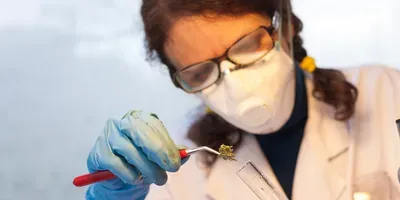The National Institute of Standards and Technology (NIST) has launched a program to help laboratories accurately measure key chemical compounds in marijuana, hemp, and other cannabis products including oils, edibles, tinctures, and balms. The program aims to increase accuracy in product labeling and help forensic laboratories distinguish between hemp, which is legal in all states, and marijuana, which is not.
As part of the Cannabis Quality Assurance (CannaQAP) program, NIST will send hemp oil samples to participating labs, which will then measure the concentration of various compounds and report back to NIST. Future exercises will involve plant material.
The labels on most cannabis products list the concentration of at least two chemical compounds: tetrahydrocannabinol, or THC, the psychoactive ingredient that produces a high, and cannabidiol, or CBD, which is not intoxicating but is sought after for its many purported health benefits. However, most laboratories have limited experience making these measurements, which can sometimes be unreliable as a result.
The goal of the program, said NIST research chemist Brent Wilson, is to help labs produce consistent measurement results. “When you walk into a store or dispensary and see a label that says 10 percent CBD, you want to know that you can trust that number.”
Those numbers are also important as a matter of criminal law. The Agriculture Improvement Act of 2018, also called the 2018 Farm Bill, legalized any cannabis material with a THC concentration below 0.3 percent. Below that number, it’s hemp. At or above that number, it’s marijuana, and illegal in many states and by federal law. A farmer’s crop can be destroyed based on that number, and interstate shipments can be seized.
Before the 2018 law, most crime labs determined if something was marijuana by testing only for the presence of THC, not by measuring the concentration. The law now requires concentration measurements, and producing accurate numbers at levels as low as 0.3 percent can be a particular challenge.
Here’s how CannaQAP will work. In the first round of exercises, NIST will send hemp oil samples—all with the same, very carefully measured concentrations of THC, CBD and 15 other cannabinoid compounds—to participating labs. Those labs won’t be told the concentrations of those compounds but will measure them and send their results back to NIST, along with information about the methods they used to do the analysis.
Related Magazine Issue: Managing A Cannabis Lab
After collecting responses, NIST will publish the measurements the labs obtained. That data will be anonymized so that the names of the individual labs are not revealed. However, the results will show how much variability there is between labs. Also, NIST will publish the correct measurements, so each lab will be able to see how accurate its measurements were and how it performed relative to its peers.
“Anonymity means that labs don’t have to worry about how their performance will be viewed,” said NIST research chemist Melissa Phillips. “Our goal is to help labs improve, not to call them out.”
Advanced Lab Management Certificate
The Advanced Lab Management certificate is more than training—it’s a professional advantage.
Gain critical skills and IACET-approved CEUs that make a measurable difference.
The NIST researchers will also assess whether some laboratory methods consistently produce better results than others. If so, they can recommend that labs adopt the better-performing methods.
Once that first round of exercises is complete and the data is published, which could take from six months to a year, NIST will run a second round of exercises. “We hope to see a tightening of the numbers the second time around,” Wilson said.
NIST is also planning to conduct future exercises with ground hemp and possibly marijuana. Those exercises will involve measuring a larger number of compounds, including terpenes—the chemicals that give different strains of marijuana their distinct aromas—and compounds that people don’t want in their cannabis such as fungal toxins, pesticides and heavy metals. Future exercises may also include extracts, concentrates, distillates, and edibles.
NIST is also working on a hemp reference material—that is, a material that comes with known, accurate measurement values. Labs will be able to use that material to validate their measurement methods. One reason these measurements vary so much from lab to lab is that, currently, there are no reference materials for cannabis.
“Labs can accurately measure how much sugar is in your orange juice because they have standardized methods and reference materials for that type of product,” said Susan Audino, a chemistry consultant and science adviser to the Cannabis Analytical Science Program of the AOAC International, a group that establishes standard methods for laboratory analysis. “But cannabis has been a Schedule I drug since the ‘70s,” she said, referring to the Drug Enforcement Administration’s designation for drugs that have the highest potential for abuse.
NIST produces thousands of standard reference materials and has a long history of conducting quality assurance programs for improving measurements. Past programs have helped labs accurately measure compounds in dietary supplements, vitamins in human serum and environmental contaminants in groundwater.
“Our goal is to support U.S. industries by helping labs achieve high-quality measurements,” Phillips said.
Laboratories that are interested in participating in CannaQAP can find more information and can register online. Registration in the first exercise involving hemp oil will be open through Aug. 31, 2020.
- This press release was originally published on the NIST news website












